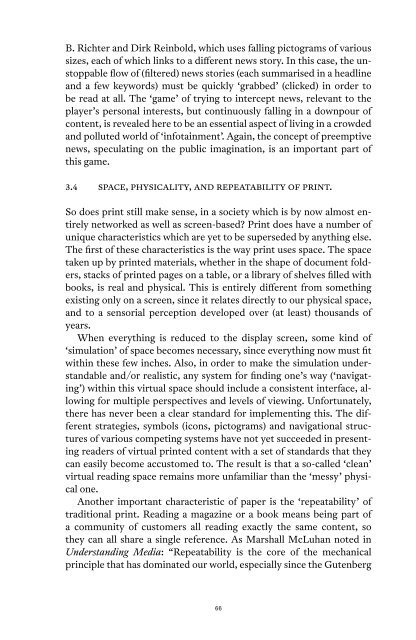Post- Digital Print - Monoskop
Post- Digital Print - Monoskop
Post- Digital Print - Monoskop
Create successful ePaper yourself
Turn your PDF publications into a flip-book with our unique Google optimized e-Paper software.
B. Richter and Dirk Reinbold, which uses falling pictograms of various<br />
sizes, each of which links to a different news story. In this case, the unstoppable<br />
flow of (filtered) news stories (each summarised in a headline<br />
and a few keywords) must be quickly ‘grabbed’ (clicked) in order to<br />
be read at all. The ‘game’ of trying to intercept news, relevant to the<br />
player’s personal interests, but continuously falling in a downpour of<br />
content, is revealed here to be an essential aspect of living in a crowded<br />
and polluted world of ‘infotainment’. Again, the concept of preemptive<br />
news, speculating on the public imagination, is an important part of<br />
this game.<br />
3.4 space, physicality, and repeatability of print.<br />
So does print still make sense, in a society which is by now almost entirely<br />
networked as well as screen-based? <strong>Print</strong> does have a number of<br />
unique characteristics which are yet to be superseded by anything else.<br />
The first of these characteristics is the way print uses space. The space<br />
taken up by printed materials, whether in the shape of document folders,<br />
stacks of printed pages on a table, or a library of shelves filled with<br />
books, is real and physical. This is entirely different from something<br />
existing only on a screen, since it relates directly to our physical space,<br />
and to a sensorial perception developed over (at least) thousands of<br />
years.<br />
When everything is reduced to the display screen, some kind of<br />
‘simulation’ of space becomes necessary, since everything now must fit<br />
within these few inches. Also, in order to make the simulation understandable<br />
and/or realistic, any system for finding one’s way (‘navigating’)<br />
within this virtual space should include a consistent interface, allowing<br />
for multiple perspectives and levels of viewing. Unfortunately,<br />
there has never been a clear standard for implementing this. The different<br />
strategies, symbols (icons, pictograms) and navigational structures<br />
of various competing systems have not yet succeeded in presenting<br />
readers of virtual printed content with a set of standards that they<br />
can easily become accustomed to. The result is that a so-called ‘clean’<br />
virtual reading space remains more unfamiliar than the ‘messy’ physical<br />
one.<br />
Another important characteristic of paper is the ‘repeatability’ of<br />
traditional print. Reading a magazine or a book means being part of<br />
a community of customers all reading exactly the same content, so<br />
they can all share a single reference. As Marshall McLuhan noted in<br />
Understanding Media: “Repeatability is the core of the mechanical<br />
principle that has dominated our world, especially since the Gutenberg<br />
66

















